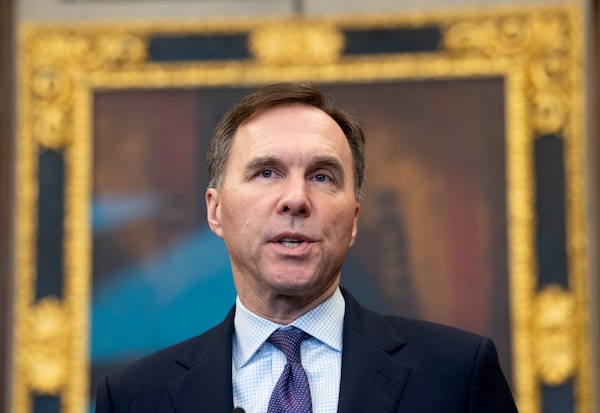
Finance Minister Bill Morneau speaks with the media in Ottawa, on Feb. 18, 2020.Adrian Wyld/The Canadian Press
The federal deficit stood at $11-billion with three months left in the current fiscal year, according to monthly tracking figures released Friday.
The Finance Department’s fiscal monitor report also showed the federal government ran a $782-million surplus in December, down sharply from the $2.5-billion surplus in December, 2018.
Over the first nine months of the current fiscal year, which ends March 31, the deficit stood at $11-billion. By way of contrast, the federal books were in a small surplus position of $324-million during the same nine-month period of 2018, which ended with a $14-billion deficit.
The latest figures come as Finance Minister Bill Morneau is preparing the government’s first budget since the fall federal election. A date has not yet been announced, but the budget is frequently released in late March.
Prime Minister Justin Trudeau will also host a First Ministers Meeting in two weeks that will include discussions of federal transfer programs, the economic impact of rail disruptions and protests by Indigenous groups and their supporters over a pipeline in Northern B.C. and the broader issues of climate change and natural resource development.
Mr. Morneau released a fiscal update in December that said the deficit for the current year is projected to be $26.6-billion, followed by $28.1-billion in 2020-21 and $22.1-billion in 2021-22.
Those projections did not account for many of the Liberal Party’s campaign promises, which means the budget is likely to show larger-than-forecasted deficit figures over the short term.
While the government has abandoned plans to set a firm date for eliminating the deficit, Mr. Morneau has pledged to keep federal debt headed downward when measured as a percentage of GDP.
The December update showed the federal debt-to-GDP ratio climbing slightly this year, to 31 per cent – up from 30.8 per cent in 2018-19 – then declining gradually to 29.1 per cent by 2024-25.
On Thursday, Parliamentary Budget Officer Yves Giroux released his annual report on the fiscal sustainability of federal and provincial government spending.
The report concluded that the fiscal landscape has improved slightly this year for Ottawa and the provinces as a whole, however, most provinces are not in a sustainable position. The report defines sustainability as a financial plan that would stabilize a government’s net debt-to-GDP ratio over the long term.
By that measure, the PBO says federal finances are sustainable and could even absorb permanent spending hikes or tax cuts of as much as $41-billion a year. If no new spending or tax cuts are introduced, the PBO says, federal finances are on track to see the federal debt-to-GDP ratio drop to zero by 2047.
But “in contrast to the federal government, subnational governments will face ever-increasing health-care costs due to population aging,” the PBO stated.
For provinces as a whole, the PBO said it would take tax increases or spending cuts totalling $6-billion a year in order to reach a sustainable level.
Quebec, Nova Scotia, Ontario and British Columbia are already on a sustainable path, the PBO said, but “all other provinces and territories have current fiscal policies that are not sustainable over the long term.”
Our Morning Update and Evening Update newsletters are written by Globe editors, giving you a concise summary of the day’s most important headlines. Sign up today.
 Bill Curry
Bill Curry